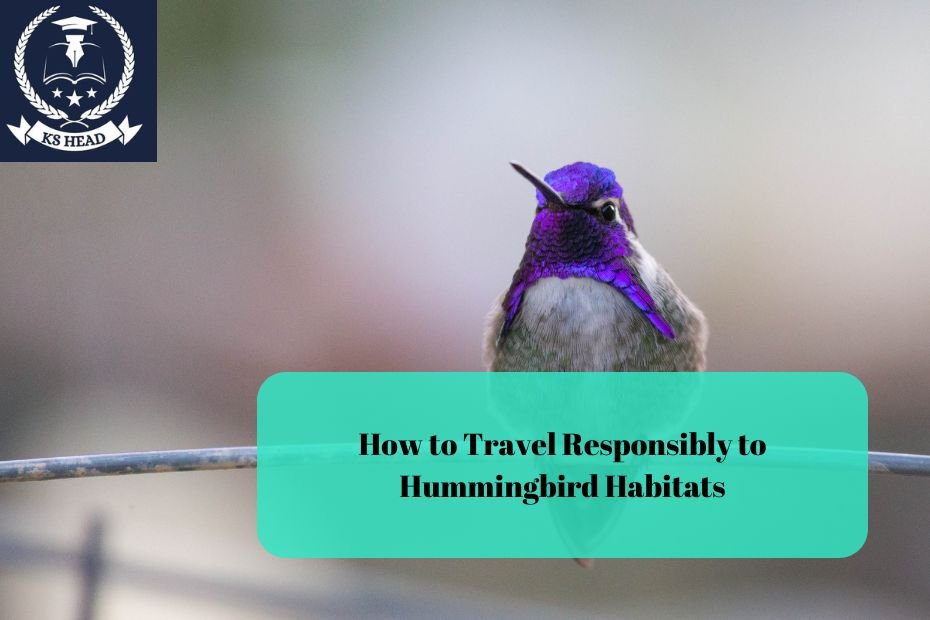Traveling to observe and appreciate hummingbirds in their natural habitats can be a rewarding experience. These fascinating creatures are not only beautiful but also play crucial roles in their ecosystems. However, as travelers, we must consider the impact of our activities on these environments and the species that inhabit them. This article will explore how to travel responsibly to hummingbird habitats, ensuring that we minimize our ecological footprint while enjoying the beauty of these remarkable birds.
1. Research Hummingbird Habitats
Understand the Ecosystem
Before embarking on your journey, it’s important to understand the specific ecosystems where hummingbirds thrive. Different species of hummingbirds inhabit diverse environments, from tropical rainforests to arid deserts. Familiarizing yourself with the local flora and fauna will enhance your experience and help you appreciate the interconnections within these ecosystems.
Identify Key Locations
Identify regions known for their hummingbird populations. Popular destinations include:
- Costa Rica: Home to over 50 hummingbird species, including the magnificent hummingbird and the violet-crowned hummingbird.
- Southwestern United States: Areas like Arizona and New Mexico are hotspots for various hummingbirds, especially during migration seasons.
- Andean Regions: Countries like Ecuador and Colombia boast incredible biodiversity, including many hummingbird species.
Timing Your Visit
Research the best times to visit these locations to witness hummingbirds in action. Many species have specific migration patterns and breeding seasons that can affect their visibility. For example, spring and summer are often the best times to see hummingbirds in North America.
2. Choose Eco-Friendly Accommodations
Opt for Sustainable Lodging
When selecting accommodations, prioritize eco-friendly hotels or lodges that focus on sustainable practices. Look for places that support local communities, utilize renewable energy, and implement waste reduction measures. Eco-lodges often have a smaller environmental footprint and contribute to conservation efforts.
Support Local Businesses
Dining at local restaurants and purchasing souvenirs from local artisans helps support the community and reduces the impact of large-scale tourism. This not only enhances your experience but also promotes sustainable economic practices.
3. Respect Wildlife and Their Habitats
Maintain a Safe Distance
When observing hummingbirds, keep a respectful distance to avoid stressing them or disrupting their natural behaviors. Use binoculars or a camera with a zoom lens to capture their beauty without getting too close. Avoid chasing or attempting to catch hummingbirds, as this can cause harm and anxiety.
Avoid Feeding Wild Hummingbirds
While it may be tempting to feed hummingbirds, it’s best to avoid offering artificial nectar or sugar water. Relying on human-provided food can disrupt their natural foraging behaviors and alter their diet. Instead, appreciate their presence in their natural habitats and let them feed on native flowers.
Do Not Disturb Nesting Sites
If you encounter nesting areas, keep your distance and do not disturb the nests. Nesting hummingbirds are particularly vulnerable, and disturbance can lead to abandonment of the nest and loss of offspring. Always respect signs and guidelines regarding wildlife observation.
4. Participate in Conservation Efforts
Volunteer with Local Organizations
Consider volunteering with local conservation organizations focused on protecting hummingbirds and their habitats. Many organizations run programs that involve habitat restoration, research, and education. Contributing your time and effort can make a meaningful impact.
Educate Yourself and Others
Learn about the ecological importance of hummingbirds and share this knowledge with fellow travelers. Raising awareness about the challenges facing these birds and their habitats can encourage responsible travel practices and inspire others to act.
Support Conservation Initiatives
Donate to or support organizations that focus on hummingbird conservation and habitat preservation. Your financial contributions can help fund research, habitat restoration, and public education campaigns aimed at protecting these vital ecosystems.
5. Minimize Your Environmental Impact
Use Sustainable Transportation
When traveling to hummingbird habitats, consider using public transportation, biking, or walking whenever possible. If you need to rent a vehicle, opt for a fuel-efficient or electric option to reduce your carbon footprint.
Reduce Waste
Carry reusable items such as water bottles, utensils, and bags to minimize waste. Avoid single-use plastics and dispose of trash responsibly. Many natural habitats have specific guidelines for waste disposal, so be sure to follow them.
Be Mindful of Your Footprint
Stick to designated trails and paths when exploring hummingbird habitats. Straying off marked paths can damage native vegetation and disrupt local ecosystems. Being mindful of your footprint helps preserve these delicate environments for future visitors.
6. Engage with Local Communities
Learn from Local Experts
Engaging with local guides and experts can enhance your understanding of hummingbirds and their ecosystems. Local guides often have invaluable knowledge about the area’s ecology, cultural significance, and conservation challenges. Supporting local guides also contributes to sustainable tourism practices.
Respect Cultural Practices
When traveling in areas where hummingbirds hold cultural significance, be respectful of local traditions and practices. Many communities view hummingbirds as symbols of beauty and resilience, and it’s essential to honor their beliefs and customs.
Conclusion
Traveling responsibly to hummingbird habitats offers an opportunity to connect with nature while contributing to conservation efforts. By researching ecosystems, choosing eco-friendly accommodations, respecting wildlife, participating in conservation initiatives, minimizing your environmental impact, and engaging with local communities, you can ensure that your travels benefit both you and the ecosystems you visit.
As we marvel at the beauty and agility of hummingbirds, let us also recognize our role in protecting their habitats. By adopting responsible travel practices, we can contribute to the conservation of these magnificent birds and the rich ecosystems they inhabit for generations to come.
FAQs
1. What is the best time to observe hummingbirds in the wild?
The best time to see hummingbirds varies by region but generally includes spring and summer during their breeding and migration seasons. Research specific migration patterns for the area you plan to visit.
2. How can I attract hummingbirds to my garden?
Plant native, nectar-rich flowers and provide feeders filled with a sugar-water solution (1 part sugar to 4 parts water). Ensure the feeders are clean and placed in a shady area.
3. Are hummingbirds territorial?
Yes, hummingbirds can be territorial, especially males during the breeding season. They may aggressively defend feeding areas and nesting sites from other hummingbirds.
4. What should I do if I encounter a baby hummingbird on the ground?
If you find a baby hummingbird, observe it from a distance to see if the parents return. If the bird appears injured or abandoned, contact a local wildlife rehabilitation center for assistance.
5. How can I learn more about hummingbird conservation?
Research organizations focused on hummingbird conservation and habitat preservation. Many offer resources, volunteer opportunities, and educational materials to help you get involved.

